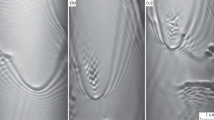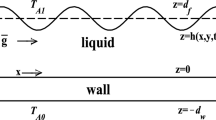Abstract
Formation and development of quasi-regular, metastable structures within laminar wavy falling films were studied using IR-thermography. These structures emerge within the residual layer between large waves. It is shown that the typical size of regular structures does not depend on the liquid flow rate and is in the order of magnitude of the critical length of the Rayleigh–Taylor instability. Also a model of thermal-capillary breakdown on the basis of a simplified force balance between the surface tension and the tangential stress as well as the energy balance in the residual layer is presented. Model predictions and experimental data are in good agreement.








Similar content being viewed by others
Abbreviations
- a IR :
-
coefficient of absorption of radiation energy (m−1)
- a :
-
temperature conductivity (m2 s−1)
- c p :
-
specific heat (J kg−1 K−1)
- c W :
-
velocity of large waves (m s−1)
- f W :
-
frequency of large waves (s−1)
- g :
-
gravitational force (m s−2)
- Ka :
-
Kapitza number \(\frac{{\sigma^{3} \rho}}{{g\mu^{4}}}\)
- l x :
-
length scale in x direction (m)
- l z :
-
length scale in z direction (m)
- L :
-
length of heat section (m)
- Ma c :
-
Marangoni number \(\frac{{q_{\rm W} {\left| {\frac{{{\rm d}\sigma}}{{{\rm d}T}}} \right|}}}{{\lambda \rho U_{\rm s}^{2}}}\)
- Ma q :
-
Marangoni number \(\frac{{q_{\rm W} {\left| {\frac{{{\rm d}\sigma}}{{{\rm d}T}}} \right|}{\left({\frac{{\nu^{2}}}{g}} \right)}^{{\frac{2}{3}}}}}{{\lambda \rho \nu^{2}}}\)
- NETD:
-
noise equivalent temperature difference (K)
- Pr :
-
Prandtl number \(Pr = \frac{\nu}{a}\)
- q W :
-
heat flux on the wall surface (W m−2)
- Re :
-
Reynolds number \(Re = \frac{\Gamma}{\nu}\)
- t :
-
time (s)
- t TC :
-
time of thermal-capillary breakdown (s)
- t W :
-
time between passing of two consecutive wave crest
- T :
-
temperature (K)
- T in :
-
inflow temperature (K)
- ΔT :
-
difference between inflow and local surface temperature (K)
- u :
-
velocity (m s−1)
- U 0 :
-
average velocity of the film (m s−1)
- U s :
-
average velocity of the gas–liquid interface (m s−1)
- U res :
-
average velocity of residual layer (m s−1)
- U TC :
-
typical thermal-capillary velocity (m s−1)
- x :
-
stream wise coordinate (m)
- y :
-
coordinate perpendicular to flow (m)
- z :
-
coordinate (m)
- δres :
-
thickness of residual layer (m)
- Γ:
-
liquid flow rate per unit length (m2 s−1)
- λ:
-
thermal conductivity (W m−1 K−1)
- λW :
-
wavelength of large waves (m)
- Λ:
-
transverse size of regular structures (m)
- Λ0 :
-
critical length of Rayleigh–Taylor instability \(2\pi {\sqrt {\frac{\sigma}{{{\left({\rho_{\rm l} - \rho_{\rm g}} \right)}g}}}},\;(\hbox{m})\)
- \({\sqrt 3}\Lambda_{0} \) :
-
wavelength of maximum growth of Rayleigh–Taylor instability (m)
- μ:
-
dynamic viscosity (kg m−1 s−1)
- ν:
-
kinematic viscosity (m2 s−1)
- ρ:
-
density (kg m−3)
- ρIR :
-
reflection degree
- σ:
-
Surface tension (N m−1)
- \(\frac{{\hbox{d}\sigma}}{\hbox{d}T}\) :
-
coefficient of temperature alteration of surface tension (N m−1 K)
References
Al-Sibai F, Leefken A, Lel VV, Renz U (2003) Measurement of transport phenomena in thin wavy film. Fortschritt-Berichte VDI 817 Verfahrenstechnik Reihe 3:1–15
Al-Sibai F (2004) Experimentelle Untersuchung der Strömungscharakteristik und der Wärmeübertragung bei welligen Rieselfilmen. Thesis of Dr.-Ing. Degree, Lehrstuhl für Wärme- und Stoffübertragung, RWTH Aachen
Bohn MS, Davis SH (1993) Thermo-capillary breakdown of falling liquid film at high Reynolds numbers. Int J Heat Mass Transf 7:1875–1881
Brauner N, Maron DM (1983) Modeling of wavy flow in inclined thin films. Chem Eng Sci 38(5):775–788
Chinnov EA, Kabov OA (2003) Jet formation in gravitational flow of a heated wavy liquid film. J Appl Mech Tech Phys 44(5):708–715
El-Genk MS, Saber HH (2002) An investigation of the breakup of an evaporating liquid film, falling down a vertical, uniformly heated wall. J Heat Transf Trans ASME 124(1):39–50
Ganchev BG (1984) Hydrodynamic and heat transfer processes at downflows of film and two-phase gas–liquid flows (in Russian). Thesis of Doctor’s Degree in Phys-Math. Sci., Moscow
Gimbutis G (1988) Heat transfer at gravitation flow of a liquid film, Mokslas, Vilnius (in Russian)
Ito A, Masunaga N, Baba K (1995) Marangoni effects on wave structure and liquid film breakdown along a heated vertical tube. In: Serizawa A, Fukano T, Bataille J (eds) Advances in multiphase flow. Elsevier, Amsterdam, pp 255–265
Kabov OA (2000) Breakdown of a liquid film flowing over the surface with a local heat source. Thermophys Aeromech 7(4):513–520
Kabov OA, Chinnov EA (1998) Hydrodynamics and heat transfer in evaporating thin liquid layer flowing on surface with local heat source. In: Proceedings of 11th international heat transfer conference, vol 2, August 23–28, Kyondju, Korea, pp 273–278
Nusselt W (1916) Die Oberflächenkondensation des Wasserdampfes. Z VDI 60:541–546
Pavlenko AN, Lel VV (1997) Heat transfer and crisis phenomena in falling films of cryogenic liquid. Russ J Eng Thermophys 3–4(7):177–210
Pavlenko AN, Lel VV, Serov AF, Nazarov AD, Matsekh AM (2002) Wave amplitude growth and heat transfer in falling intensively evaporating liquid film. J Eng Thermophys 11(1):7–43
Wang BX, Zhang JT, Peng XF (2000) Experimental study on the dryout heat flux of falling film. Int J Heat Mass Transf 43:1897–1903
Zaitsev DV, Kabov OA, Cheverda VV, Bufetov NS (2004) The effect of wave formation and wetting angle on the thermocapillary breakdown of a falling liquid film. High Temperature 42(3):450–456
Acknowledgment
This work was financially supported by the Deutsche Forschungsgemeinschaft (Project Re 463/31-1 and SFB 540) and the Russian Foundation of Basic Research (Project 03-02-04027-NNIO-a) in a collaboration project.
Author information
Authors and Affiliations
Corresponding author
Appendix
Appendix
In this part different approaches for the determination of the critical dimensionless heat flux are presented.
Experimental data for laminar-wavy and turbulent films were described in [8] by the following empirical dependencies:
For 100 < Re < 200 in [8] the scattering of data was up to 50 %, for Re < 100 no experimental data has been recorded. It can be seen in Fig. 9 that this dependence suggests lower values than the current experimental data. The difference can be explained by the fact that in [8] the experimental data was obtained only for a water film flow with a relatively long heated section. In this case evaporation effects and thus a shift in the thermophysical properties could have appeared.
In [10] the empirical dependence of the critical Marangoni number on the Reynolds number for a short heat section (6.5 mm length along the flow) for laminar waveless falling films was obtained:
In this case the length of the heated section is in the same order of magnitude as the thermal entry length [10]. Therefore this curve indicates higher values than our experimental data.
It was shown in [9] that for the 2D case the modified critical Marangoni number is constant:
With the film surface velocity based on Nusselt’s film theory \(U_{\rm s} = \frac{g}{{2\nu}}\delta^{2}_{m}, \) expression (25) can be transformed into:
It can be seen, that only dependence (26) is in the same order of magnitude as our experimental data.
Other dimensionless parameters for generalisation of experimental data were used in [3] and [16]. In [3] the data for dimensionless breakdown heat flux is approximated in the form:
With elementary transformations (27) can be transformed into:
Figure 10 shows that (28) again leads to lower values than our experimental data. Here, as in case of Eq. 23, evaporation effects could have appeared, because this dependence was obtained for water and for a 30% glycerol–water solution at a 2.5 m long test section for Re > 959.
A generalisation for water and aqueous solution of alcohol is presented in [16]:
This correlation leads to results which exceed current data by more than one order of magnitude. It can be partially explained by the fact that dependence (29) was obtained for stable dry spots, whereas the new data was recorded for the formation of local instable dry spots.
Rights and permissions
About this article
Cite this article
Lel, V., Stadler, H., Pavlenko, A. et al. Evolution of metastable quasi-regular structures in heated wavy liquid films. Heat Mass Transfer 43, 1121–1132 (2007). https://doi.org/10.1007/s00231-006-0187-6
Received:
Accepted:
Published:
Issue Date:
DOI: https://doi.org/10.1007/s00231-006-0187-6






